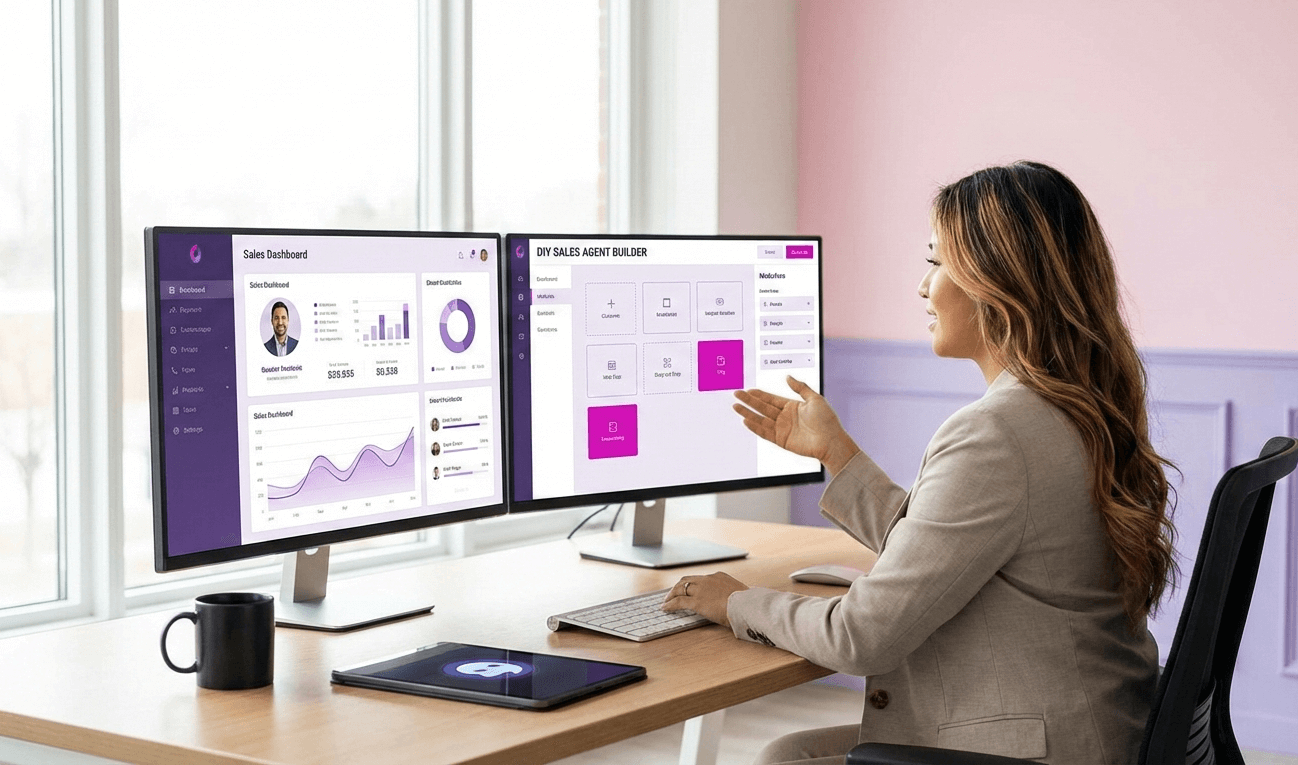“Streamline sales with AI-powered email automation. Learn practical tips, see real examples, and discover how SalesCloser AI and its agents boost engagement, personalize communication, and close more deals.”
In today’s fast-paced business world, staying ahead means constantly looking for more innovative work methods. For sales teams, this often means tackling mountains of emails, following up with countless leads, and trying to personalize every single message. It’s a demanding task, and frankly, it can be exhausting. But what if there were a way to make this process easier and more effective? This is where AI-powered email automation transforms how businesses engage with prospects, nurture leads, and ultimately, close more deals.
This article delves into how companies can dramatically improve their sales processes using AI-driven email automation. We’ll share practical tips, look at real-world examples, and discuss best practices to help your team succeed. You’ll see the significant advantages of automation in your sales outreach and follow-up strategies. We’ll also introduce a powerful tool, SalesCloser AI, and explain how its AI agents can help your business achieve more intelligent engagement, personalized communication, and seamless workflow automation, substantially increasing your closed deals.
The Shifting Landscape of Sales: Why Automation is No Longer Optional
For years, sales success depended heavily on manual effort: cold calling, sending individual emails, and tracking every interaction by hand. While dedication remains crucial, manual processes simply cannot keep up with the demands of modern markets. Customers expect instant, personalized responses; sales cycles are often complex and lengthy. Managing all this manually means wasting valuable time on repetitive tasks rather than building relationships and securing deals.
Consider this: the sales automation market is growing rapidly, expected to reach $8.9 billion by 2025. This isn’t just a trend; it’s a fundamental shift in how successful businesses operate. Companies that embrace AI automation report impressive results, with some seeing an average 30% increase in sales productivity. The message is clear: adopting this technology is essential to compete and grow.
Understanding AI-Powered Email Automation: Beyond Basic Autoresponders
Many people think of email automation as simple autoresponders—those generic messages that confirm a subscription or acknowledge an inquiry. However, AI-powered email automation is entirely different. It goes far beyond fundamental, preset triggers.
AI-driven automation uses sophisticated machine learning algorithms to analyze vast amounts of data. It identifies patterns, predicts customer behavior, and even understands the context of conversations. This capability allows it to deliver highly personalized messages at scale, adapt to real-time market conditions, and effectively guide prospects through the sales funnel.
Think of it as having a super-smart sales assistant who never sleeps, learns from every interaction, and always knows the best next step. This is the power AI brings to your email strategy.
How AI Enhances Email Communication:
- Contextual Understanding: AI uses Natural Language Processing (NLP) to grasp the meaning and sentiment of email content. It can understand inquiries, identify pain points, and detect urgency in a prospect’s message.
- Predictive Analytics: By analyzing historical data, AI can predict which leads will most likely convert, what content will resonate best, and the optimal time to send an email. This takes the guesswork out of outreach.
- Dynamic Content Generation: AI can dynamically create personalized content for each recipient instead of relying on static templates. It pulls information from your CRM, past interactions, and public data to craft uniquely tailored messages.
- Behavioral Triggers: AI systems can monitor prospect behavior—like email opens, clicks, website visits, or content downloads—and trigger automated, relevant follow-up actions based on these signals.
The Concrete Benefits: Why Your Sales Team Needs AI Email Automation Now
Adopting AI-powered email automation isn’t just about efficiency, but fundamentally transforming your sales outcomes. The benefits are far-reaching and directly impact your bottom line.
1. Significant Time Savings
Sales representatives spend a considerable portion of their day on email-related tasks, including drafting, sending, and tracking. AI automation can take over many of these repetitive duties. Imagine saving 2-3 hours daily per sales rep on email management. This reclaimed time can then be redirected to high-value activities, such as:
- Strategic Planning: Developing more effective sales strategies.
- Relationship Building: Spending more time on calls, demos, and in-person meetings.
- Complex Problem Solving: Addressing unique customer challenges that require human insight.
This shift lets your sales team focus on what they do best: selling and building strong client relationships.
2. Enhanced Personalization at Scale
Generic emails are easily ignored. Inboxes are crowded, and prospects are increasingly adept at filtering irrelevant messages. Personalization is key to cutting through the noise, but manual personalization for hundreds or thousands of leads is impractical.
AI solves this challenge by enabling hyper-personalization at scale. It leverages data from your CRM, past interactions, and publicly available information to craft emails that resonate deeply with individual recipients. This means:
- Tailored Content: Messages directly address a prospect’s needs, industry, or recent interactions.
- Relevant Offers: AI can suggest products or services most likely to appeal to a particular lead.
- Improved Engagement: Personalized emails lead to significantly higher open rates, click-through rates, and ultimately, response rates.
This level of personalization builds trust and makes prospects feel valued, rather than just another name on a mailing list.
3. Improved Lead Quality and Qualification
AI can analyze lead data to identify the most promising prospects. It looks at various signals, such as engagement levels, demographic information, and historical conversion data, to score leads accurately. This ensures your sales team focuses on leads most likely to convert.
Furthermore, AI can automate the initial qualification process through automated surveys or interactive email sequences. This pre-qualifies leads before a human sales rep gets involved, ensuring valuable sales time is spent on genuinely interested and suitable prospects.
4. Faster Deal Cycles
AI can accelerate your sales cycle by automating follow-ups, personalizing communications, and ensuring timely responses. Prospects receive relevant information precisely when needed, keeping them engaged and efficiently moving them through the funnel. Automated reminders for demos, proposals, and next steps ensure no opportunity falls through the cracks. This speed often translates directly into more deals closed in a shorter timeframe.
5. Increased Conversion Rates and Profitability
All these benefits—time savings, personalization, better lead quality, and faster cycles—converge to boost conversion rates. Prospects receiving timely, relevant, and personalized communications are more likely to convert into paying customers. Increased conversions directly lead to higher revenue and greater profitability for your business.
Leading companies are already seeing these results. For example, Salesforce’s Einstein AI platform has reportedly increased sales productivity by 25%. HubSpot’s AI tools have shown up to a 20% increase in conversion rates. These are not isolated incidents but indicators of a broader trend towards AI-driven success in sales.
Practical Steps to Implementing AI-Powered Email Automation
Implementing AI-powered email automation doesn’t have to be overwhelming. You can start small, demonstrate value, and gradually scale your efforts. Here’s a step-by-step guide:
Step 1: Define Your Goals and Identify Pain Points
Before diving into tools, clearly articulate what you want to achieve. Are you aiming to:
- Reduce manual follow-up time?
- Improve email open rates?
- Increase lead qualification efficiency?
- Shorten your sales cycle?
- Boost overall conversion rates?
Once your goals are clear, identify the pain points AI can address in your current email process. This might include:
- Generic mass emails.
- Delayed follow-ups.
- Difficulty personalizing messages.
- Leads are falling through the cracks.
- Inconsistent messaging across the team.
Step 2: Choose the Right Tools and Software
The market offers a growing number of AI-powered email automation tools. When selecting a platform, consider:
- Integration Capabilities: Does it integrate seamlessly with your existing CRM (e.g., Salesforce, HubSpot), marketing automation platforms, and communication tools?
- AI Functionality: What specific AI capabilities does it offer (e.g., NLP, predictive analytics, content generation, AI agents)?
- Ease of Use: Is the interface intuitive? Can your sales team quickly learn to use it effectively?
- Scalability: Can the tool grow with your business needs?
- Support and Resources: Does the provider offer good customer support and training materials?
- Customization: Can you tailor the automation workflows and email templates to your unique sales process and brand voice?
Look for solutions that offer robust features for automated email drafting, personalized content creation, optimal send time prediction, and intelligent follow-up sequences. Specifically, consider tools that provide specialized AI agents to handle different aspects of the sales process.
Step 3: Integrate with Your CRM and Other Sales Tools
For AI email automation to be truly effective, it must be deeply integrated with your Customer Relationship Management (CRM) system. This creates a bidirectional flow of information:
- CRM to AI: AI tools pull crucial data from your CRM—contact details, lead status, interaction history, recent activities—to personalize emails and inform automation triggers.
- AI to CRM: The AI platform updates the CRM with email engagement data (opens, clicks, replies), allowing sales reps to see a complete picture of every lead’s journey.
This integration reduces manual data entry, improves accuracy, and ensures your sales team always has the most up-to-date information. It also logs AI-generated actions and makes them visible to the entire team.
Beyond CRM, consider integrating with tools for:
- Form Submissions: Trigger automated responses when a prospect fills out a website form.
- Call Transcriptions: Use AI to draft follow-up emails based on key points from sales call transcripts (e.g., from tools like Fathom or Grain).
- Customer Support Platforms: Ensure a unified customer experience by connecting sales emails with support interactions.
Step 4: Design Your Automation Workflows
This is where you map out the “if this, then that” logic for your email sequences. Start with common sales scenarios:
- Cold Outreach: Develop a sequence of personalized introduction emails. If a prospect opens Email 1 but doesn’t reply, send Email 2 with a slightly different angle.
- Lead Nurturing: Create workflows for prospects who download specific content, attend a webinar, or visit certain pages on your website. The emails should provide additional relevant information and guide them towards a demo or consultation.
- Post-Demo Follow-Up: Automate tailored follow-up emails after a product demonstration, summarizing key discussion points and outlining next steps.
- Proposal Follow-Up: Set up automated reminders or value-added content deliveries after sending a proposal.
- Win-Back Campaigns: Design sequences for inactive leads or past customers who might be ready to re-engage.
- Event-Triggered Emails: Send specific emails based on a prospect’s actions, such as abandoning a cart or reaching a particular stage in the sales pipeline.
When designing workflows, keep them modular and flexible. Start simple, then add complexity as you gain confidence and data.
Step 5: Craft Compelling, AI-Optimized Email Content
While AI can generate content, human oversight remains vital. Your sales team should review and refine AI-generated drafts to ensure they align with your brand voice and strategic messaging. Focus on:
- Clear Call-to-Actions (CTAs): Every email should have a clear purpose and guide the recipient to the next step.
- Concise Language: Get to the point quickly. Use short sentences and paragraphs.
- Benefit-Oriented Messaging: Focus on how your product or service solves the prospect’s problems.
- Strong Subject Lines: Use AI to test and optimize subject lines for higher open rates.
- A/B Testing: Continuously test different versions of your emails (subject lines, body copy, CTAs) to see what performs best.
Remember, the goal is to sound human and build a connection, even with AI’s help; authenticity matters.
Step 6: Monitor, Analyze, and Optimize
Implementation is not a one-time event. Continuous monitoring and optimization are crucial for maximizing your results. Track key metrics such as:
- Open Rates: How many people are opening your emails?
- Click-Through Rates (CTR): How many people are clicking on links within your emails?
- Reply Rates: How many prospects are responding to your automated emails?
- Conversion Rates: How many leads from your automated sequences convert into customers?
- Time Saved: Quantify the time your sales team is reclaiming.
- ROI: Calculate the return on investment for your AI automation efforts.
Use these insights to refine your workflows, improve your email content, and adjust your strategies. AI tools often provide analytics dashboards that make this analysis straightforward. Continuously test, learn, and adapt.
Introducing SalesCloser AI: Your Partner in AI-Powered Sales
As you consider implementing AI-powered email automation, consider platforms specifically designed to support sales teams. SalesCloser AI stands out as a robust AI sales tool offering specialized AI agents engineered to help businesses close more deals through thoughtful engagement, personalized communication, and workflow automation.
SalesCloser AI is not just another email tool; it’s an integrated platform equipped with intelligent AI agents that understand the nuances of the sales process. It helps you move beyond generic outreach to brilliant, responsive communication.
How SalesCloser AI Empowers Your Sales Team with AI Agents:
- Intelligent Lead Nurturing Agents: SalesCloser AI’s dedicated AI agents create dynamic lead-nurturing paths. These agents analyze prospect behavior and engagement to ensure they receive the correct information at the right time. This means fewer leads fall through the cracks and more move efficiently through your sales funnel. These agents work tirelessly to keep prospects engaged without direct human intervention at every step.
- Personalized Communication Agents: At its core, SalesCloser AI excels at personalization through its specialized communication agents. These agents pull data from your CRM and other sources to help you craft emails that speak directly to individual prospects. This isn’t just about inserting a name; it’s about understanding their pain points, industry, and stage in the buying journey. The agents help you generate resonant content, leading to higher engagement and more meaningful conversations.
- Automated Sales Outreach Agents: Say goodbye to manually sending every follow-up. SalesCloser AI’s outreach agents automate repetitive tasks, freeing up your sales team to focus on high-value activities. These agents ensure timely and consistent communication without constant human supervision, whether for initial contact, follow-up reminders, or checking in after a specific event. This consistency means no lead is overlooked.
- Seamless Workflow Automation Agents: SalesCloser AI features workflow automation agents that integrate with your existing sales tech stack to create a smooth, automated workflow. From capturing new leads to scheduling follow-ups and updating CRM records, these agents automate routine tasks, reducing manual effort and potential errors. This allows your sales team to manage a larger pipeline with greater efficiency.
- Data-Driven Insight Agents: The AI agents within SalesCloser AI gather and process data, providing actionable insights into email performance, lead engagement, and sales pipeline health. You can see what’s working, where prospects are getting stuck, and how to optimize your strategies for better results. This data-driven approach means you’re always making informed decisions, guided by the continuous learning of the AI agents.
By leveraging SalesCloser AI and its specialized AI agents, businesses can ensure that every email is innovative, personalized, and strategically aligned to move deals forward. This helps sales teams engage more effectively, nurture relationships more intelligently, and ultimately close more business.
The PIQ Advantage: A Deeper Dive into Prospect Intelligence
In addition to SalesCloser AI’s powerful capabilities, integrating with tools like PIQ can further enhance your AI-powered email automation strategy. PIQ, which stands for Prospect Intelligence Quotient, is designed to provide deeper insights into your leads, giving your sales team a significant advantage.
While SalesCloser AI’s agents streamline communication and workflow, PIQ enriches your understanding of who you are talking to. It gathers and analyzes extensive data on prospects, including their company’s financial health, industry trends, technological stack, recent news, and social media activity.
How PIQ Supercharges Your Email Automation:
- Enriched Personalization: PIQ’s detailed insights make your AI-powered emails even more targeted. Instead of just personalizing based on a name and company, you can reference specific company initiatives, recent achievements, or challenges they might face. This level of detail makes your outreach incredibly relevant and impactful.
- Proactive Engagement: PIQ can alert you to key events or changes within a prospect’s organization (e.g., a new funding round, a leadership change, or a significant product launch). Your automated email sequences can then be triggered to respond to these events with highly timely and relevant messages, positioning your solution as a perfect fit for their evolving needs.
- Better Lead Scoring: By providing a comprehensive view of a prospect’s potential, PIQ helps refine your lead scoring models. This means your AI automation can prioritize and nurture the truly high-value leads more effectively, ensuring your sales team focuses its efforts where they will yield the greatest return.
- Identifies Decision-Makers: PIQ helps identify key decision-makers and influencers within target accounts, allowing your AI-driven emails to reach the right people directly. This reduces wasted effort and speeds up the sales process.
- Competitive Intelligence: PIQ can offer insights into a prospect’s existing tech stack and competitive landscape. This information can be fed into your AI email automation to craft messages highlighting your competitive advantages or integration capabilities.
By combining the automation prowess of SalesCloser AI’s agents with the deep prospect intelligence of PIQ, your sales team gains an unparalleled ability to engage, personalize, and convert. It’s about automating emails and making every email an intelligent, data-driven interaction that moves the needle forward.
Best Practices for Successful AI Email Automation
Adopting the tools isn’t enough; how you use them truly matters. Follow these best practices to maximize the impact of AI-powered email automation:
1. Maintain a Human Touch
While automation handles the heavy lifting, the human element remains vital.
- Personalization Beyond Templates: Ensure humans review and refine AI-generated content to ensure it sounds natural and aligns with your brand’s voice. Avoid robotic language.
- Strategic Human Intervention: Identify points in your sales process where a personal call or a custom-written email will have the most significant impact. Automation should free up time for these crucial human interactions.
- Empathy: Even automated messages should convey empathy and understanding of the prospect’s challenges.
2. Segment Your Audience Smartly
Don’t treat all prospects the same. Use your CRM data and PIQ insights to create particular audience segments.
- Industry-Specific Segments: Tailor messages to different industries’ unique challenges and opportunities.
- Behavioral Segments: Group prospects based on their interactions with your website, content, or previous emails.
- Demographic Segments: Consider company size, role, or geographic location factors.
The more granular your segmentation, the more relevant and compelling your automated emails will be.
3. Focus on Value, Not Just Selling
Every email should offer value to the recipient. This could be:
- Educational Content: Blog posts, whitepapers, or case studies relevant to their interests.
- Problem-Solving Insights: Practical tips or solutions to common industry challenges.
- Exclusive Offers: Discounts or early access to features.
Shift the mindset from “selling” to “helping.” Prospects are more likely to engage with and trust your brand when you consistently provide value.
4. Optimize for Mobile Devices
A significant portion of emails are opened on mobile devices. Ensure your automated emails are responsive and look great on any screen size.
- Concise Content: Keep paragraphs short and use bullet points for readability.
- Clear CTAs: Make buttons and links easy to tap.
- Image Optimization: Use images sparingly and ensure they load quickly.
5. Be Mindful of Email Frequency
Don’t overwhelm your prospects with too many emails. Over-automation can lead to unsubscribes and marked-as-spam complaints.
- Pacing: Design your sequences with appropriate time gaps between emails.
- Recipient Control: Provide clear options for recipients to manage their communication preferences.
- Engagement-Based Frequency: Use AI to adjust frequency based on a prospect’s engagement level—send more to highly engaged leads, less to inactive ones.
6. Test, Measure, and Iterate Constantly
As highlighted earlier, continuous optimization is paramount.
- A/B Test Everything: Experiment with different subject lines, opening lines, CTAs, and send times.
- Analyze Performance Metrics: Regularly review open rates, click-through rates, reply rates, and conversion rates.
- User Feedback: Pay attention to direct feedback from prospects and your sales team.
- Adapt and Refine: Use data and feedback to improve your workflows and content continuously. What works today might not work tomorrow, so stay agile.
The Future of Sales is Automated, Personalized, and Intelligent
The sales landscape is evolving, and AI-powered email automation is no longer a luxury but a necessity for businesses aiming for sustainable growth. By embracing this technology, your sales team can move beyond the grind of manual tasks and dedicate more energy to what truly matters: building strong relationships and closing valuable deals.
From intelligent lead nurturing to hyper-personalized communication and seamless workflow automation, tools like SalesCloser AI, with its specialized AI agents, offer comprehensive solutions to streamline your sales process. When combined with deep prospect intelligence tools like PIQ, your ability to engage effectively and convert leads reaches new heights.
Start small, learn fast, and scale confidently. Intelligent automation will pave the path to a more efficient, productive, and profitable sales future. Your sales team and your bottom line will thank you for it.
Common Questions About AI-Powered Email Automation
Q1: Is AI-powered email automation only for large enterprises?
A1: Not at all. While large enterprises benefit, small and medium-sized businesses (SMBs) can gain a competitive edge by implementing AI-powered email automation. Many platforms offer scalable solutions for businesses of all sizes, often with tiered pricing plans. For SMBs with limited sales resources, AI automation can effectively act as an extension of their team, allowing them to manage more leads and personalize communication without a massive headcount increase. The key is to start with clear goals and scale your efforts as you see results.
Q2: Will AI replace my sales team?
A2: No. AI is a tool designed to augment your sales team’s capabilities, not replace them. Its agents handle repetitive, time-consuming tasks like drafting emails, sending follow-ups, and data entry. This frees up your sales professionals to focus on higher-value activities: building relationships, strategic problem-solving, conducting complex negotiations, and delivering personalized demos. AI helps sales teams be more productive, efficient, and practical, allowing them to close more deals by concentrating on human-centric interactions that AI cannot replicate. It turns sales reps into strategic advisors rather than administrative assistants.
Q3: How do I ensure my AI-generated emails sound human and not robotic?
A3: This is a crucial point. To ensure your AI-generated emails sound human:
- Provide Clear Guidelines: Train your AI tool with examples of your brand’s voice, tone, and preferred messaging style.
- Human Review and Editing: Always have a human sales rep review and refine AI-generated drafts. They can add nuances, personal anecdotes, or details that make the email feel authentic.
- Focus on Conversational Language: Encourage the AI to use natural language, avoiding jargon or overly formal phrasing.
- A/B Test Different Tones: Experiment with variations in tone and style to see what resonates best with your audience.
- Incorporate Specific Details: Ensure the AI pulls and integrates specific, relevant details from your CRM (with human oversight) to make the email highly personalized, naturally making it sound less generic. Tools like SalesCloser AI are designed to facilitate this level of personalization through their intelligent agents.
Q4: What are the main challenges when implementing AI email automation?
A4: While beneficial, implementation can have challenges:
- Data Quality: AI relies on clean, accurate data. Poor CRM data can lead to ineffective or irrelevant automated emails.
- Integration Complexities: Connecting AI tools with existing systems can sometimes be complex, requiring technical expertise.
- Change Management: Getting your sales team to adopt new tools and workflows requires training, clear communication, and demonstrating the benefits.
- Over-Automation: There’s a risk of sending too many emails or making them sound too generic, leading to unsubscribes.
- Measurement and Optimization: It takes time and effort to track metrics and continuously optimize your automation strategies correctly.
- Regulatory Compliance: It is essential to ensure that your email practices comply with data privacy regulations (e.g., GDPR, CAN-SPAM).
Addressing these challenges proactively ensures a smoother and more successful implementation.
Q5: How long does it take to see results from AI-powered email automation?
A5: The timeline for seeing results can vary depending on the complexity of your implementation, the size of your sales team, and how effectively you optimize your campaigns. However, many businesses report seeing initial positive impacts within a few weeks to a few months.
- Initial Improvements (Weeks 1-4): You might quickly notice time savings for your sales team, increased email open rates, and more consistent follow-ups.
- Tangible Results (Months 1-3): Within this period, you should start to see improvements in lead qualification rates, better engagement with prospects, and reduced sales cycle length for automated sequences.
- Significant ROI (Months 3-6+): As you gather more data, refine your strategies, and scale your automation efforts, you can expect to see significant improvements in conversion rates, increased pipeline velocity, and a clear return on your investment in AI technology.
Consistent monitoring and optimization are key to accelerating and maximizing these results.








